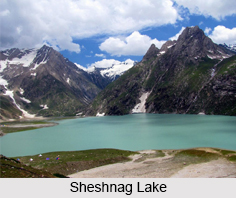 Sheshnag Lake is an alpine high altitude oligotrophic lake in India. Sheshnag Lake is the meeting point for the pilgrims who are heading for Amarnath Yatra. The lake appears greenish in colour because of its lush green meadows that surrounds it making it a breathtaking beauty to admire.
Sheshnag Lake is an alpine high altitude oligotrophic lake in India. Sheshnag Lake is the meeting point for the pilgrims who are heading for Amarnath Yatra. The lake appears greenish in colour because of its lush green meadows that surrounds it making it a breathtaking beauty to admire.
Location of Sheshnag Lake
Sheshnag Lake is situated at the track leading to Amarnath cave 23 kilometres from Pahalgam in Anantnag district of Kashmir valley in Jammu and Kashmir. Sheshnag Lake is situated 120 kilometres east from Srinagar in Srinagar District of Jammu and Kashmir and 23 km from Pahalgam, which is one of the popular hill stations in India.
Geography of Sheshnag Lake
Sheshnag Lake is located at an elevation of 3590 meters. It has a maximum length of 1.1 kilometers and maximum width of 0.7 kilometres.
Mythology on Sheshnag Lake
According to the Hindu mythology, Sheshnag means the "King of Snakes" and the lake was dug by Sheshnag himself. It is believed by the Hindus that Sheshnag stays in this Lake even today. It is one of the most ancient places of pilgrimage for the Hindus, as it lies on the track of Amarnath cave.
Flora and Fauna of Sheshnag Lake
Sheshnag Lake is home to many types of fishes among which are the brown trout. It freezes during winter, and is inaccessible during this season due to heavy snowfall. It is surrounded by green lush meadows and mountains covered by snow.
Tourist Attractions in Sheshnag Lake
Sheshnag Lake is one of the famous tourist destinations in Jammu and Kashmir. It is mostly fed by melting of snow and streams coming down from mountain tops. It drains out through a stream which joins Lidder River at Pahalgam.
Visiting Information of Sheshnag Lake
Sheshnag Lake can be accessed at about 113 km by road up to Chandanwari from which ponies can be hired to cover a trek of 7 km upslope to reach the Sheshnag Lake. Amarnath cave is situated 20 kilometres north of this lake. The best time to visit Sheshnag Lake is from the month of June to September that is in the summer and pre winter months. It is because during winter it freezes and forms a snow land.















